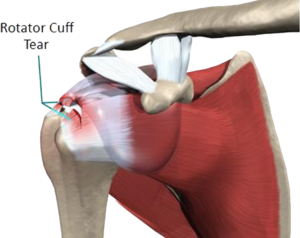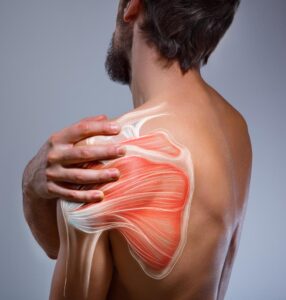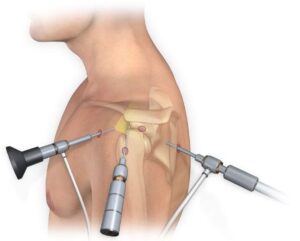Rotator Cuff
There are various shoulder treatment available now-a-days. The shoulder joint boasts the most extensive range of motion among all joints and is highly dynamic in its functionality. The “rotator cuff,” a collection of four muscles and tendons that surrounds the shoulder joint, provides stability and permits arm overhead motion. Injuries to the rotator cuff occur often in both young and old people. A fall, a sports accident, routine overhead arm movements, and tendon degradation can all result in rotator cuff issues.
boasts the most extensive range of motion among all joints and is highly dynamic in its functionality. The “rotator cuff,” a collection of four muscles and tendons that surrounds the shoulder joint, provides stability and permits arm overhead motion. Injuries to the rotator cuff occur often in both young and old people. A fall, a sports accident, routine overhead arm movements, and tendon degradation can all result in rotator cuff issues.
A torn rotator cuff can be successfully treated by Dr. Preetesh Choudhary, a specialist in shoulder care at CHL Hospital in Indore, facilitates patients in returning to their active routines. Read more about Rotator Cuff Injury.
Frozen shoulder
The condition referred to as frozen shoulder can lead to intense shoulder discomfort and limited shoulder movement. A “stiff shoulder” often entails the complete loss of function and mobility in the shoulder joint.
shoulder movement. A “stiff shoulder” often entails the complete loss of function and mobility in the shoulder joint.
When scar tissue forms around the shoulder joint, the soft tissue of the shoulder joint starts to stiffen and compress, leading to frozen shoulder. Restricted movement occurs due to adhesions or the formation of scar tissue. The shoulder treatment like physical therapy, steroid injections etc. are there for frozen shoulder problem. As shoulder discomfort and stiffness worsen over time, the shoulder is moved less frequently. In certain situations, the discomfort and loss of motion can get so bad that going about daily tasks might become challenging. Read more about Frozen Shoulder.
Shoulder Arthroscopy - Shoulder Treatment by surgery
This is an extensive range of shoulder treatment for the injuries that can be successfully treated with arthroscopic shoulder surgery. During a shoulder arthroscopy, the tissues surrounding and inside the shoulder joint are examined and repaired using a tiny camera, an arthroscope, and thin surgical instruments which reduce pain and hasten recovery by treating a shoulder injury with extremely small incisions.
successfully treated with arthroscopic shoulder surgery. During a shoulder arthroscopy, the tissues surrounding and inside the shoulder joint are examined and repaired using a tiny camera, an arthroscope, and thin surgical instruments which reduce pain and hasten recovery by treating a shoulder injury with extremely small incisions.
Arthroscopic shoulder surgery is used for shoulder treatment to treat a number of shoulder injuries, including:
- Rotator cuff injuries
- Shoulder fractures
- Dislocated shoulder and shoulder instability
- Labral and SLAP tears
- Frozen shoulder
- AC joint injuries/arthritis
- Shoulder impingement
- Read more about Shoulder Arthroscopy.
Shoulder Dislocation
The shoulder, which has the greatest range of motion of any joint in the human body, can become restricted after a dislocation. The ball and socket within the shoulder separate during a dislocated shoulder. As a result, the shoulder might dislocate in all directions, including multiple directions in some cases. The probability of the shoulder dislocating again rises. When the muscles, tendons, bones, and ligaments that surround the shoulder do not function properly to secure the ball and socket joint, shoulder instability develops. Shoulder treatment like Physical therapy, medication are available for shoulder dislocation. Read more about Shoulder Dislocation.
Symptoms of a Dislocated Shoulder
Common dislocated shoulder symptoms include:
- Significant pain, can also be felt in the arm
- Inability or difficulty moving the arm
- Arm numbness
- A “popping” sensation
- Shoulder weakness
- Loss of range of motion
- Visual deformity of the shoulder joint
Shoulder Joint Replacement - Shoulder Treatment by surgery
The cartilage lining the shoulder joint enables a seamless, painless range of motion and provides protection to the bones. When cartilage starts to degrade due to regular wear and strain, shoulder arthritis can be a crippling condition. Osteoarthritis, a degenerative condition often seen in older individuals, is marked by inflammation, swelling, and persistent shoulder discomfort. Individuals who have attempted non-surgical remedies like arthroscopic shoulder surgery, physical therapy, medications, and injections without relief from arthritic pain may qualify for a shoulder treatment, namely- shoulder replacement. Known as shoulder arthroplasty, this surgical procedure allows patients to regain a normal, active lifestyle post-operation. Read more about Shoulder Replacement Surgery.
SLAP Tear
Superior Labrum Anterior and Posterior is referred to as SLAP. The top (superior) portion of the labrum is hurt in SLAP injuries. SLAP tears affect both the front (anterior) and back (posterior) surfaces of this connection point, and the biceps tendon may also be affected by the injury.
Repeated shoulder movements, particularly in overhead sports like throwing or weightlifting, can lead to the development of labrum tears.
However, many SLAP tears occur due to the gradual degeneration of the labrum over time. The superior labrum’s tearing or fraying can be recognised as a typical ageing process in people who are older than 30 to 40 years old. This is distinct from a young person’s acute injury. Read more about SLAP Tear.
Shoulder Trauma
Injury to the shoulder occurs frequently. Injuries can range from a dislocated shoulder resulting from a fall onto the shoulder to a fractured collarbone or shoulder blade (clavicle) due to a high-speed car accident. Everyone suffers from a shoulder injury at some point in their lives, that much is clear.
A shoulder fracture is classified by which bone is involved, such as a humerus fracture.
There are three distinct bones that can experience a fracture:
-Collarbone, or clavicle fracture
-Upper arm bone, or humerus fracture
-Shoulder blade, or scapula fracture
Shoulder Impingement Treatment
Being the body’s most mobile joint, the shoulder can sustain serious injuries including shoulder impingement. An injury known as shoulder impingement refers to the impingement (pinching) of the rotator cuff tendons. The persistent, repetitive pinching causes shoulder pain, edema, and inflammation. Due to the increased incidence of this injury among swimmers, the condition is sometimes known as “swimmer’s shoulder.”
Shoulder impingement can occur without clear cause and is highly prevalent. The issue arises when the rotator cuff tendons in the shoulder joint undergo damage from rubbing against the bones and ligaments of the joint. Swimmers and other athletes are more likely to suffer from “swimmer’s shoulder,” which is frequently brought on by repeated usage leading to bone spurs. Since bone spurs frequently form as a patient ages, age may also play a role in this injury. This ailment is also accompanied by subacromial bursitis and tendon irritation. One suffering from trauma shoulder treatment like RICE (Rest Ice Compression Elevation) and anti inflammatory medication can be followed to cure the pain & injuries. Read more about Shoulder Trauma.
Bursitis
Bursa inflammation is known as bursitis. A closed, liquid-filled sac called a bursa serves as a cushion and gliding surface to lessen friction between human tissues. Near the main joints, such as the shoulders, elbows, hips, and knees, the major bursa are found adjacent to the tendons.
surface to lessen friction between human tissues. Near the main joints, such as the shoulders, elbows, hips, and knees, the major bursa are found adjacent to the tendons.
Bursitis often only lasts a short time. It may limit movement but usually does not lead to deformities.
Bursitis can occur in any bursa throughout the body, although there are several common types, such as:
- Retromalleolar tendon bursitis
- Posterior Achilles tendon bursitis
- Hip bursitis
- Elbow bursitis
- Knee bursitis
- Kneecap bursitis
Read More about Shoulder Treatment namely Bursitis Treatment.